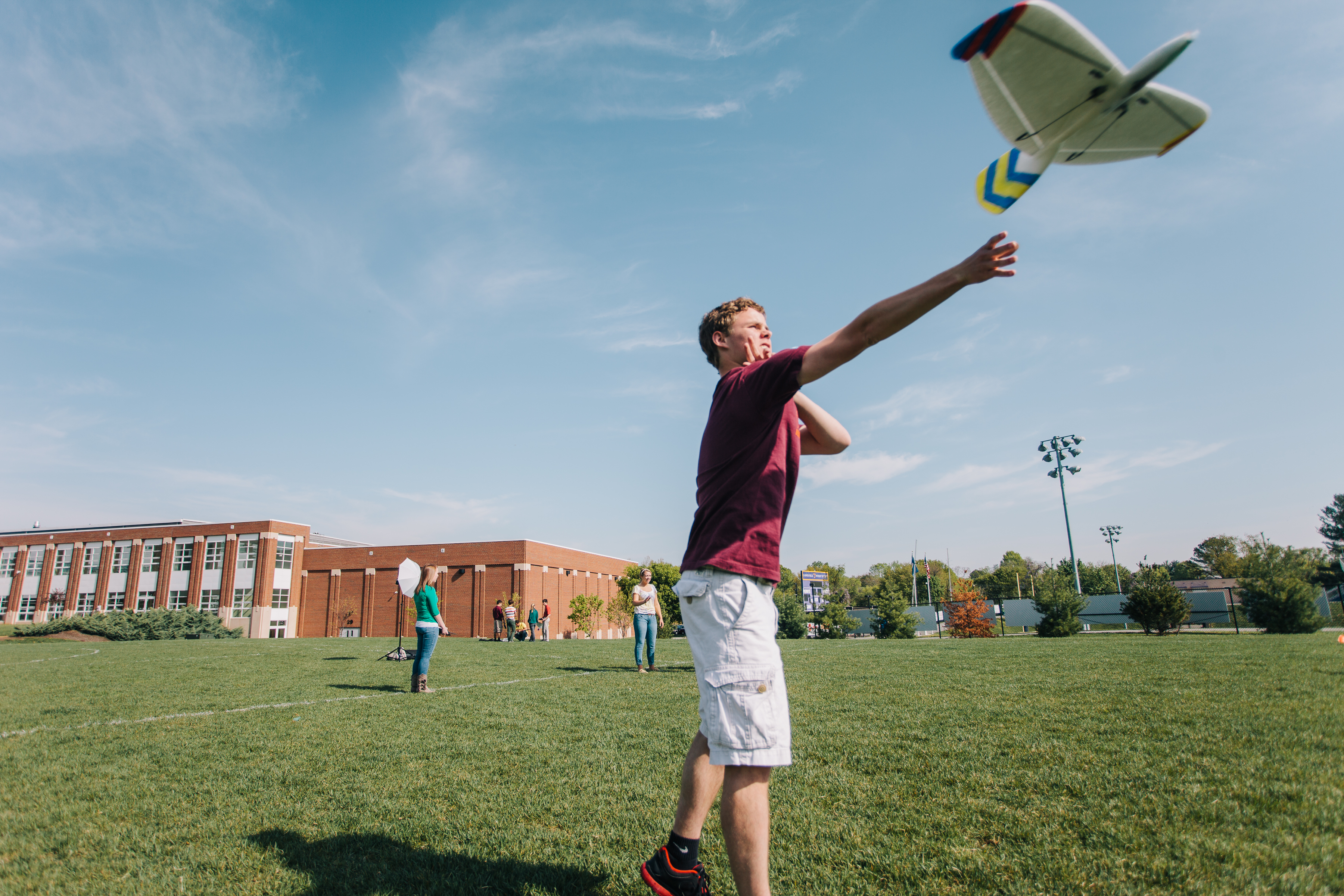High school biology students learn about the physics of flying by studying flight paths of animals and microbes

It’s a perfect spring day for flying — sunny, warm, and a strong breeze whips through the air. Too bad Cindy Bohland’s biology students at the Roanoke Valley Governor’s School are wingless.
What they do have to ride the winds, however, are small remote-controlled Styrofoam gliders. As Bohland’s high school students fling the planes into the air — hoping they catch a current that will flit them from air stream to air stream like mechanical chimps swinging from ephemeral branch to branch — they are putting the principles of flight they have learned in the classroom to the test in the field.
This flight lab was developed by Renee Pietsch of Snohomish, Wash., a graduate student in biological sciences who worked with David Schmale, an associate professor of plant pathology, physiology, and weed science in the College of Agriculture and Life Sciences, to fine-tune the curriculum. Pietsch is also a fellow in the MultiSTEPS program — an initiative partially funded by the National Science Foundation's Integrative Graduate Education and Research Traineeship program and by Virginia Tech’s Interdisciplinary Graduate Education program. The initiative promotes interfacing between the fields of engineering and biology to investigate dynamic transport processes in multiscale biological systems.
The program’s approach is multidisciplinary and its objective is to produce science and technology professionals in higher education, as well as promote the sciences as an appealing profession for young people.
“This unit was designed to teach students about the beauty of flight in biological systems. Birds, gliding mammals, and microorganisms can fly, but they do it in different ways,” said Schmale. “The students got to learn about flying by testing flight principles themselves with gliders. I can’t think of a better way to translate classroom concepts into action.”
While Styrofoam planes may not be objects found preserved in the glass jars of formaldehyde in a biology classroom, Bohland’s students have in fact studied biological systems as part of this flight lab.
The gliders the students take into the field help illustrate the more mechanical principles of flight such as thrust, drag, lift, and stall, but the Lilliputian airships are also used to represent the mechanics of how flight works for the animals they’ve studied in the classroom. Animals such as flying snakes, gliding mammals, and organisms like microscopic spores.
“This lab gave my students the opportunity to experience the interdisciplinary nature of science while having fun building and flying gliders,” said Bohland. “Having biology students involved in a lab experience that teaches them about principles of flight is exactly what the Science, Technology, Engineering and Mathematics education program is about.”
Students in Bohland’s class learned about the principles of flight by studying three different kinds of animals with Pietsch — birds that use powered flight, a colugo (a mammal found in Southeast Asia that flies by gliding), and flying snakes that glide by elongating their width and creating an air foil with their bodies. Students also learned about passive transport and how crops are affected by airborne plant pathogens such as wheat rust.
“The students really enjoyed the lab,” said Pietsch, “They obviously liked the snake part. I think because it’s kind of science fiction to see snakes that fly.”
Learning complicated flight principles was more enjoyable for the students because of the in-field flying demonstration as well.
“I didn’t know anything about flight going into the class,” said McKenna Luzynski, 17, of Roanoke, Va. “It was interesting to see all of the principles that go into keeping a glider in the air.”
Ben Cardenas and Parker Benzie, both 17 and from Roanoke, Va., were partners in creating their glider, Loco Lacumba.
“Just seeing things you wouldn’t expect to see flying in nature was eye-opening,” said Benzie. “The principles will apply to the physics I am going to take next year.”
Sebastian Wellford, of Roanoke, Va., had been enjoying huge success with navigating his plane, Blazing Hawk with his partner Sam Roller also of Roanoke.
“We do a lot of labs involving technology and I’ve never really understood flight patterns, so it’s fun to see flying in action. It combines a game with actual science,” said Roller.
As the in-field demo drew to an end, The Blazing Hawk went out in a blaze of glory, taking a terrible nose dive straight into the green turf of the football field and sustaining a fuselage-length crack requiring a major repair.
While animals may glide effortlessly on their own, humans still have to resort to mechanical flight to get airborne, or just the simple pleasure of flying a radio-controlled plane on a windy day.





